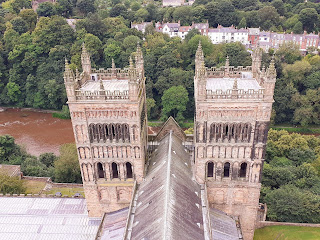John Forster, one of Victorian England’s most prominent political journalists, literary critics and biographers, was born on 2nd April 1812, in what was described as a “little yellow house … in Fenkle Street”, Newcastle. Curiously, his life was almost exactly contemporaneous with that of author Charles Dickens, who was also born in 1812, but who died six years prior to Forster in 1870. The two men would become unlikely friends, with Forster going on to pen the first, and perhaps most definitive, biography of the great wordsmith, which was completed in 1874 as the Life of Charles Dickens.
Forster came from a well-to-do ancestral lineage; but by the time John was born in 1812, the fortunes of his particular line had fallen considerably. His father, Robert, was a butcher and cattle-dealer in Newcastle, who, it was said, married “slightly beneath himself” – his wife, Mary, being the daughter of a Gallowgate cow-keeper. John was the second-born child of four, and though his father has remained relatively obscure, his mother was remembered as “a gem of a woman”, being kind and affectionate in the extreme. The family were financially comfortable, though not excessively so.
When he was still a child, the family moved around the corner to Low Friar Street; and then, when John was 16, onto 5 Green Court (the entrance to which was across Newgate Street from Darn Crook). None of their abodes were especially opulent, but they always aimed high – the family being members of the congregation of the Unitarian meeting house in Hanover Square, regarded in hindsight now, perhaps, as an enlightened, progressive force in the town. John was schooled at the Royal Grammar School, then situated on Westgate Road, and grew up to be a well-balanced, kindly soul, much like his mother, effortlessly advancing to the role of Head Boy. By 16 he was already physically and intellectually mature, and a keen antiquarian and bookworm, to boot. He frequented the Literary & Philosophical Society, garnered an interest in journalism and, especially, the theatre, of which he was a passionate follower. He even had a play of his own performed at the (old) Theatre Royal when he was a mere 16.
Richard Renton, in his biographical John Forster and His Friendships of 1912, tells of our man’s surprising emergence from his “murky” and “grimy” native Newcastle. John Forster, being one of the very few men of letters to so emerge from this supposed cultural backwater, nevertheless picked up friends and acquaintances aplenty along his way in life, carefully guided in his early years by his Uncle John – who also helped him secure a place at Cambridge University. He soon thereafter moved to the newly-formed University College, London, studying law; and though he eventually entered the Inner Temple, he never became a practising lawyer. Instead, he followed his preferred path, becoming, eventually, a respected literary and drama critic. Additionally, he wrote to considerable acclaim, including Lives of the Statesmen of the Commonwealth (1836-39) and a Treatise on the Popular Progress in English History. His much admired efforts and influence grew year-on-year, and he soon began moving in the upper echelons of the literary world. Among the great and the good he befriended was the world-famous Charles Dickens, who was only too pleased to entrust Forster with the scrutiny of his future novels – which Forster read in their hand-written, manuscript form, and, no doubt, suggested amendments and corrections where necessary. What better way to beat the critics than to have the premier literary commentator of the day scrutinise your work prior to publication?
Throughout his career he edited several esteemed periodicals, and penned many biographical and historical essays. Though for some years he had been preparing a biography of Jonathan Swift, he dropped this in favour of a similar tribute – a lengthy two-volume biography of his friend Charles Dickens, published in 1872 and 1874, respectively, in the wake of the novelist’s death. He never did get that Swift biography properly finished prior to his own death in London in 1876. Additionally, it should be mentioned that Forster was also heavily involved with the work of the Lunacy Commission during 1855-72.
His valuable collection of manuscripts, including many original hand-written copies of Dickens’ novels, were bequeathed to South Kensington Museum. All of the many subsequent studies of Dickens’ life have, of course, leant heavily on Forster’s original biographical work, as well as the considerable archive he left on his death. His influence over and interactions with the great novelist have even secured mention for Forster as a character in several fictionalised works centred on the life of Dickens in the decades following their respective deaths.
Note: It is unlikely Forster had any offspring; though a widow, Eliza Ann, is mentioned in the inscription on the family vault in Kensal Green Cemetery. They had married in 1856 – perhaps a little too late to have children.
Additionally, as well as Richard Renton’s work detailed above, readers may wish to seek out John Forster: A Literary Life by James A. Davis (1983).
[taken from my latest book Newcastle-upon-Tyne: Fragments of the Past, vol.3 - see left-hand column, and click on the link for further info]














_page-0001.jpg)










